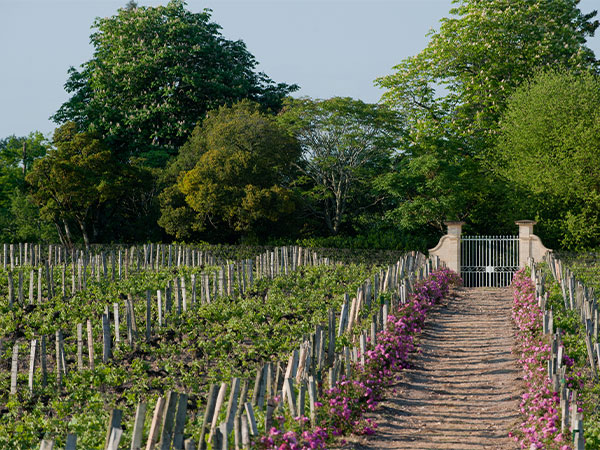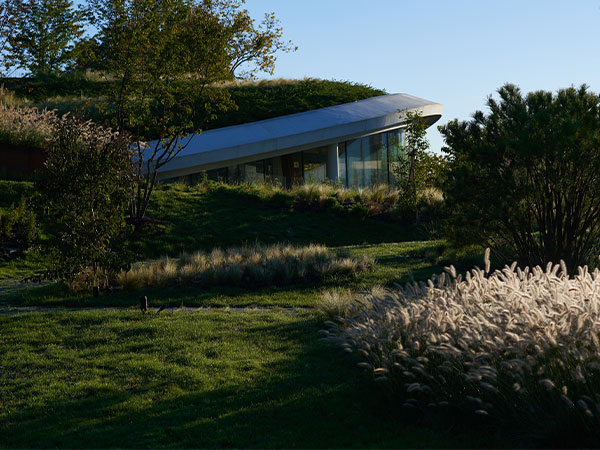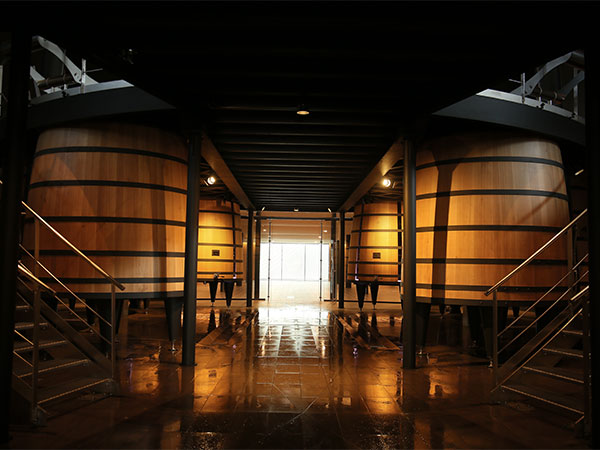Ed. Note: In addition to writing about wine, Master of Wine Fiona Morrison manages the Thienpont family’s négociant business in Etikhove, Belgium and, with her husband, Jacques, manages their three estates—Le Pin in Pomerol, L’If in St-Emilion and L’Hêtre in Castillon. The Thienpont family is involved with a number of other châteaus in Bordeaux, most notably Vieux Château Certan in Pomerol. Here is her report after tasting more than 100 of the top wines from 2020 throughout Bordeaux during En Primeur week.
Capping a great trilogy of Bordeaux vintages—2018, 2019 and 2020—the wines of this latest vintage are marked by climate change and acquired skills, both in growing and in winemaking. Together, they have combined to produce some stunning results.
Known in the past for its maritime climate, Bordeaux has shifted over the last decade from rain and humidity during the growing season to a different pattern: wet winters and dry, sunny summers. In contemporary Bordeaux, grapes can ripen fully without those green, herbaceous notes that were part of the Bordeaux lexicon of the past. And there is much less risk of rot. On the downside, there are the extreme weather patterns associated with climate change—spring frosts, hailstorms and periods of drought have become annual challenges. If growers manage to navigate them, they are rewarded by grapes that are much healthier than in the past.
The 2020 growing season began with lots of rain in November and December 2019 and again in the spring of 2020; temperatures were mild from the new year until March (there was no real winter to speak of). This led to an early bud break, from March 20 to 26, which presaged an early vintage. Tropical conditions during spring led to problems of downy mildew, mitigated by a period of dry, sunny weather starting mid-May, which coincided with a precocious flowering and continued right through the summer. Temperatures moderated in mid-August, when thunderstorms brought rain (more fell in the Médoc than the Right Bank). Hot, dry, sunny weather in early September led to cooler days and rain from the 19th to the 27th, with mixed, windy weather during the last days of the month. Harvesting finished in early October before heavy rain fell for the rest of the month.


Photo by Guillaume de Laubier.
As in the last two years, water stress in the dry summer months was a challenge—Cheval Blanc, made up of almost equal proportions of clay parcels and gravel plots, registered the biggest water shortage ever recorded at the property. Clay and limestone soils with adequate water reserves did better, which is why many of the top wines in 2020 were produced on the Pomerol plateau and in St-Emilion. Interestingly, both Château Ausone and Château Cheval Blanc recorded higher levels of merlot in their blends than cabernet franc, which may have been impacted by water stress in parcels where clay was not present. Vineyards with a decent amount of clay in Pessac-Léognan and in the Médoc (such as in St-Estèphe) were less challenged; the more than 100 mm of rain that fell on the Left Bank in mid-August gave a welcome boost to the cabernet sauvignon vines.
It may be that the vines are adapting to the new weather patterns. This trio of sunny years may have allowed the plants to build up their defenses and find a “go-slow” mode during the peak of the heat and drought, when previously they would have shut down. Of course, this is linked to the quality of the terroir, since it clear that the best vineyards cope better in these days of climate change. Within each estate, especially in the 250-plus acres of many Médoc estates, what were once the top parcels may be too gravelly and dry in some contemporary vintages; parcels that have more clay or are north- or east-facing are coming into their own. Technical directors at these châteaux have more precise soil maps of their vineyards than they did 20 years ago; they can adapt parcel selection to those subtle differences. Linking all this together is vine and soil health, and the microbial biome in the soil, especially around the vines’ roots. The differences between traditional viticulture and more research-driven, precise viticulture, as practiced, for example by Lafleur and Cheval Blanc, were highlighted in the 2016 vintage. Since then, more growers have been gently tilling their soils rather than ploughing them, so as not to disturb the root systems and microbial life.
Another interesting phenomenon is that while alcohol levels in 2020 are relatively high, the perception of alcohol on the palate is more balanced and the wines seem less hot in the finish than those found in previous hot vintages such as 2010 and 2016. In the past, overripe grapes were the problem as growers were obsessed with IPT levels (the total polyphenol index) as a measure of ripeness with less concern about what was happening to the pH levels. According to the ISVV (the Bordeaux Institute of Vines and Wines), wines with high levels of alcohol in the past were produced most often from overripe grapes and during this physiological process, acids were degraded.
For the third year in a row, winemakers and tasters were surprised by the wonderful freshness that was apparent in the wines right from the start. The 2020s have none of the overcooked flavors of 2003. Recent warmer conditions and drier summers have ripened the grapes earlier than in the past and picking decisions have changed from anticipating the latest moment to pick to achieve ripeness, to having the luxury of choosing when to pick. Acidity is still present in these modern wines as the pH levels remain quite low. It is the tannins that carry the acidity this year. Instead of freshness being found in the juicy fruit as in 2019, the key to the 2020 wines is this tannic tension and energy that drives the mid-palate expression.
Although climate and terroir played an important role in this vintage, accounting for the fact that there is more variation in quality than in 2019, winemakers played a decisive role in the success of the 2020 wines. Those that have adapted their vineyard management to the summer drought have succeeded better than most. The most successful growers no longer reflexively turn to leaf plucking and green harvesting; instead, their key practices are in nourishing and protecting the soil with cover crops; sustaining biodiversity to help pollination and control insect populations; and pruning and shoot positioning to keep the vine well aerated and the clusters shaded.
The right picking dates were crucial. In a significant contrast to fashions of the recent past, there is now a tendency to look for freshness rather than overripeness by picking earlier. This is the first vintage in memory that the Médoc finished harvesting before the Right Bank. And on the Right Bank, at the Thienpont properties in Pomerol, St-Emilion and the Côte de Castillon, this was the first vintage in which we harvested all of them at the same time. The timing was based on whether the vines were getting stressed or if the rainfall around September 18 through 24 changed the physiological characters of the grapes (lower alcohol, larger berry size, better extractable tannins, etc.).
The pendulum swing was clear at Château Troplong Mondot, for instance, which is picking almost a month earlier than it did in the past; Thomas Duclos, the new wunderkind in Bordeaux, is behind that decision and is also helping the rapidly improving Château Giscours these days. Bordeaux insiders are comparing the fresh philosophy of Duclos with the rich philosophy of Michel Rolland, noting that as the pendulum swings in favor of fresher, more balanced wines, the market is reacting positively to these wines. There has, in fact, been a fundamental shift in St-Emilion, with wines such as châteaus Pavie and Canon joining Troplong Mondot on the bright side of freshness. (This may be a consideration in the châteaus that are hoping for advancement in the new 2022 St-Emilion classification. The dossiers need to be submitted by the end of June this year and speculation is rife that both Château Figeac and Château Canon are set to join the other “A” class first growths.)
In the cellar, various sophisticated sorting options, which a decade ago were considered the key to top-quality wine, were decommissioned at châteaus such as Haut-Bailly and Léoville-Las-Cases, where the fruit in 2020 was so healthy, they were unnecessary. Instead of lengthy pumping over of the must in the vats, winemakers from Calon-Ségur in St-Estèphe to L’Evangile in Pomerol practice “infusion,” keeping the cap wet while limiting the amount of oxygen the musts receive. Since the impression of alcohol can be exacerbated by aging the wine in new oak barrels, today it is hard to find any estate using 100 percent new oak. And the trend is to use oak “muids” of 300 to 600 liters (instead of the traditional 225-liter Bordeaux barrique).


Photo by Florent Larronde
As more châteaus conduct soil studies to map their vineyards, many are using smaller vats, amphora and clay jars to separate out the different parcels. To accommodate this proliferation of small-lot fermentations, there now seems to be more building going on throughout Bordeaux than at any time in the last two decades. The new cellars at châteaus Figeac, Haut-Bailly and Lynch-Bages gained the most attention during En Primeur week, but there are also major projects going on or planned at châteaus Lafite-Rothschild, Léoville Las Cases and Haut Brion, to mention the big boys.
Finally, there was the impact of the COVID-19 pandemic on the vintage, particularly at harvest. Wearing masks in the heat of September was arduous for everyone. Testing the picking teams daily to ensure no one was infected was vital; having to isolate a whole team, especially in the Médoc where teams are much larger, would have been a disaster, as it was hard to find pickers. At least two directors of Bordeaux châteaus contracted COVID-19 and are yet to fully get their sense of smell back. The ISVV has issued a protocol on how to retrain your brain to pick up aroma signals while those affected wait and hope that their sense of smell will eventually return. Needless to say, it made the blending of their 2020 wines challenging.
After an abundant harvest in 2019 (perhaps not fully felt by the market as châteaus are increasingly holding back stocks to be released at a later, COVID-free moment), yields for the 2020s are generally down as much as 10-20 percent from the prior year. It varies by appellation and individual château but the primary causes were mildew, hail and small berries with less juice due to the heat and drought.
It was amusing to hear producers in the Médoc speak with surprise at the quality of their merlot this year and to see that the variety played a major role in plumping out the wines in St-Estèphe and Margaux (two successful regions). Cabernet sauvignon, given a boost by the August rainfall, ripened around the same time as the merlot. Not to ignore the white and the sweet wines of Bordeaux, there are lovely fresh, fruity, floral whites which were picked at the end of August and the beginning of September. As for Sauternes, the harvest was complicated by the lack of rain at the start and too much at the end but those who waited to finally pick botrytized grapes, such as Château Suduiraut, were rewarded by rich, complex wines, albeit in tiny quantities.
Speaking generally about the red wines, they have deep colors, dark fruit and often more floral than juicy aromas. On the palate, there is excellent fruit concentration and exciting, taut, fresh tannins which are silky and energetic. Alcohol levels are slightly lower on the Left Bank (a very comfortable 12.8 percent at Lafite and 13.8 percent at Calon-Ségur compared with 14.5 percent in 2019) but still high on the Right Bank (14.5 percent being a rough average) due to higher percentages of merlot. Still, as stated earlier, the alcohol does not seem to be a factor in many of my tasting notes.


Photo by Virginie Ohrensstein.
In reply to the inevitable question to winemakers as to where they would situate the 2020 wines stylistically, most said the wines lie somewhere between the 2018 and the 2019 vintages. Others point to the precision and the structure of the 2016s. I have hesitated to use the word “classic” to describe the wines, but the success of the tannins tends to make the wines seem more poised, restrained, and classy than the juicy exuberance of the charming and pretty 2019s. One thing for certain is that a decade ago, we would never have believed that the marginality of Bordeaux’s climate would be capable of producing tannins with this level of maturity, texture and complexity. This looks to be a vintage which will age impressively, and we will be talking about this trio of vintages for a very long time.
Here is my round-up of the most successful wines:
Left Bank & Graves:
Calon-Ségur, Dufort Vivens, Haut-Brion, Lafite, Léoville-Las-Cases, Margaux, Mouton-Rothschild, Palmer, Pichon-Baron and Pichon-Lalande with potential good values at Haut-Bages Libéral, Phélan-Segur, Cantemerle and Haut-Marbuzet.
Right Bank (excluding Thienpont family properties):
Ausone, Eglise-Clinet, Figeac, Lafleur, Pavie, Pétrus, Trotanoy with potential good values at Chauvin, Feytit-Clinet, Grand Corbin d’Espagne, La Chenade, Petit-Village, Roc des Cambes.
In addition to writing about wine, Master of Wine Fiona Morrison manages the Thienpont family’s négociant business in Etikhove, Belgium and, with her husband, Jacques, manages their three Bordeaux estates—Le Pin in Pomerol, L’If in St-Emilion and L’Hêtre in Castillon.
This is a W&S web exclusive. Get access to all of our feature stories by signing up today.
















